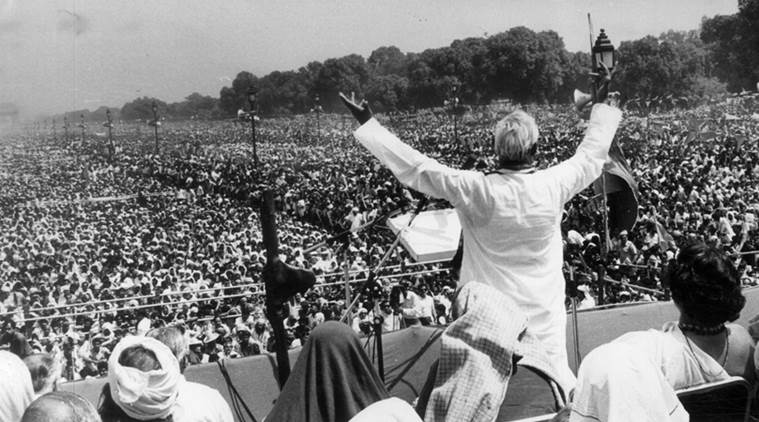 Political leader Atal Behari Vajpayee addressing a Rally at Boat Club New Delhi in 1991. (Express archive photo by RK Sharma)
Political leader Atal Behari Vajpayee addressing a Rally at Boat Club New Delhi in 1991. (Express archive photo by RK Sharma)
SUMMING up their association of 65 long years, BJP veteran L K Advani released a brief message on the death of Atal Bihari Vajpayee, on August 16, 2018. “I cherish the memories of my long association with him,” he wrote, “right from our days as Pracharaks of the RSS, to the inception of the Bharatiya Jana Sangh, the struggle of the dark months during the Emergency leading to the formation of the Janata Party, and later the emergence of the Bharatiya Janata Party in 1980.”
In that crisp summary of Vajpayee’s story lay the tale of the churning within the political life of post-Independent India. If that churning has involved essentially four major political streams, the nationalist Congress, the Socialists, the Communists and the cultural nationalists or the Jana Sangh/BJP, where the last stands now is in no small measure the doing of Vajpayee.
A late arrival on the political arena, the Jana Sangh/BJP ideology has firmly upended the electoral hierarchy that once saw it as outsiders, to now setting the political agenda. And the road that has led the BJP here was paved by the former prime minister.
1951-1967
“We are wedded to the mission of India’s renaissance and reconstruction. Mother India is calling upon her children,” Dr Syama Prasad Mookerjee said at the founding session of the Bharatiya Jana Sangh on October 21, 1951, in Delhi. Vajpayee was present as one of the founder members.
It was early on that Mookerjee embraced those two aims, “renaissance” and “reconstruction”, to set the Jana Sangh apart from the other prevailing political thoughts. The formulation harked the cultural heritage of India, and sought to “correct” the “historical injustices” since “the advent of Muslim rulers in India”. This was unlike the other three political strands — as represented by the Congress, Socialists and Communists — with their avowed agendas against colonial, imperial and Brahminical influences in socio-political life.
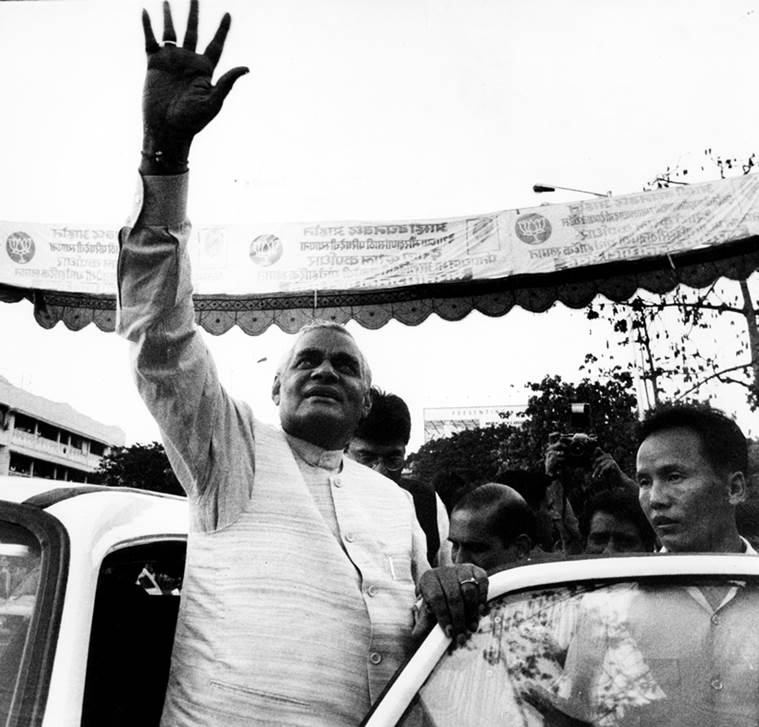 Prime Minister Atal Behari Vajpayee waving hand to the crowd at Seva Bhavan. (Express archive photo by A Srinivas)
Prime Minister Atal Behari Vajpayee waving hand to the crowd at Seva Bhavan. (Express archive photo by A Srinivas)
It was important for the Jana Sangh to make that differentiation to nudge a space for itself in an electoral field dominated by the Congress, which had the first mover advantage as the main inheritor of the freedom struggle. The Socialists and Communists too had been around a while, falling within the umbrella of the Congress’s broad socialism.
The Congress, as well as the Socialists and Communists also had stalwarts to lead them. If the Congress had Jawaharlal Nehru, Sardar Vallabhbhai Patel, Rajendra Prasad, Maulana Azad, C Rajagopalachari, Jagjivan Ram, the Socialists had Acharya Narendra Dev, Jay Prakash Narayan, Ram Manohar Lohia, J B Kriplani, while the Communists had M N Roy, P Sundarayya, Ajoy Ghosh, S A Dange, S V Ghate, A K Gopalan, P C Joshi, B T Ranadive and E M S Namboodiripad.
In the first Lok Sabha elections held after Independence (1951-52), the gap between the Jana Sangh and the others was laid bare. The Congress won 364 of 489 Lok Sabha seats, the Socialists (Socialist Party and Kisan Mazdoor Praja Party) 21, and the Communists 16. The Jana Sangh won only three seats, including one by Mookerjee.
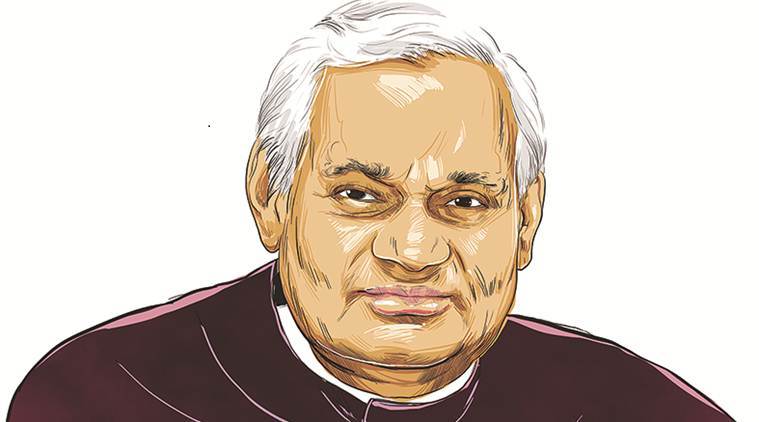 Our last respect to Atal Bihari Vajpayee, a giant politician with exceptional oratory skills and a dedicated swayamsevak, who ruled over the hearts of countless Indians.
Our last respect to Atal Bihari Vajpayee, a giant politician with exceptional oratory skills and a dedicated swayamsevak, who ruled over the hearts of countless Indians.
In the next elections, 1957, the Jana Sangh’s tally went up to just four. While Mookerjee had died by then, one of its new MPs was Vajpayee. The Communists won 27 seats, the Socialists 19 and the Congress 371.
The 1962 polls were again patchy for the Jana Sangh, with Vajpayee himself losing. However, before the next election (1967), the Jana Sangh had shown the political flexibility needed for it to bridge the yawning gap between its political narrative and that of the others. This was also a recognition of the presence of an anti-Congress sentiment — which has held the BJP in good stead till now.
In the wake of the humiliating defeat to China in the 1962 war, the Jana Sangh and other opposition parties together put up candidates against the Congress in four by-elections. Socialists Kriplani and Lohia contested from Amroha and Farrukhabad respectively, while the Swatantra Party’s Minoo Masani was fielded from Rajkot and then Jana Sangh president Deendayal Upadhyaya from Jaunpur. All won, except Upadhyaya.
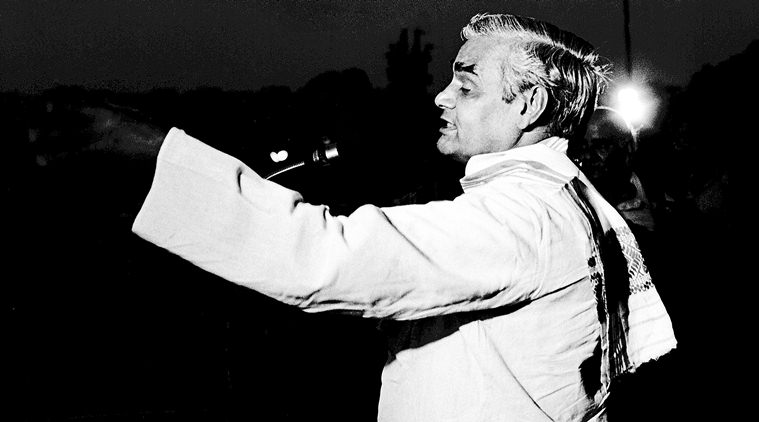 “Vajpayeeji was a true democrat who recognised the legitimate role of the Opposition.”
“Vajpayeeji was a true democrat who recognised the legitimate role of the Opposition.”
This successful experiment saw a repeat in the 1967 elections, with the Jana Sangh joining the Socialists and Communists to deny power to the Congress in Uttar Pradesh, Madhya Pradesh and Bihar through the Samyukta Vidhayak Dal (SVD) governments.
In the Lok Sabha, the Jana Sangh posted its best performance, winning 35 seats. In his book The Hindu Nationalist Movement and Indian Politics: 1925 to the 1990s, Christophe Jaffrelot says Vajpayee was an advocate of coalitions and proposed a resolution to this effect in the Jana Sangh’s general council in April 1967. “When challenged to explain the participation of his party in coalitions that lacked any ideological coherence, he replied that the Jana Sangh’s reason for being in politics was to gain power.”
1967-1972
Soon after the Jana Sangh had exhibited the political expediency of 1967, the burden of taking this forward fell upon Vajpayee. He took over as Jana Sangh president after Upadhyaya was mysteriously found dead in February 1968.
In his book My Country My Life, Advani recounts that Vajpayee’s start was full of problems, with the SVD coalitions faltering, the Jana Sangh faring badly in some 1969 mid-term elections, and party leader Balraj Madhok challenging his leadership.
“Madhok disagreed with Deendayalji and Atalji on their economic policies, which he thought had a ‘leftward’ tilt. The party in those days was quite cautious in responding to Indira Gandhi’s populist measures such as bank nationalization… Atalji was clear that the Jana Sangh should be considered a ‘common man’s party’, and not as a party of the rich and powerful,” Advani writes, while also emphasising that Vajpayee was opposed to “the Soviet or Chinese model of development”.
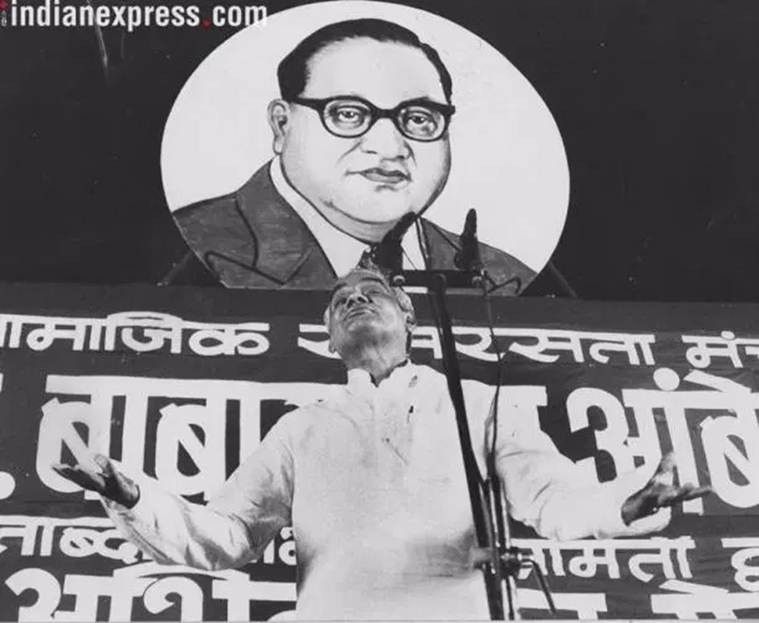 Atal Bihari Vajpayee served was Prime Minister of India for three non-consecutive terms between 1996 and 2004. (Express Archive photo)
Atal Bihari Vajpayee served was Prime Minister of India for three non-consecutive terms between 1996 and 2004. (Express Archive photo)
Vajpayee’s assessment of the appeal of Indira’s populist policies appeared correct when Indira returned to power with a clear majority in the 1971 Lok Sabha elections with the slogan of ‘Garibi Hatao’. The Opposition, that fought jointly and tied up with the Congress (O), formed by Congress rebels who had split from the party in 1969, could together get only 49 seats — the Jana Sangh 22, Congress (O) 16, Swatantra Party 8, and Socialists 3. But for the first time, the Opposition tally was led by the Jana Sangh.
By now, the party had also made another move for expansion by getting Rajmata Vijayaraje Scindia to its fold, through the SVD experiment. This gained it a big footprint in MP, and in 1971, Vajpayee contested not from UP but Gwalior Lok Sabha constituency.
However, with the Jana Sangh’s tally sliding, including in some Assembly elections that followed, Vajpayee asked senior vice-president Bhai Mahavir to preside over the party’s national session in 1972, in his place, to ensure a “frank discussion” on the party’s poll performance. This was the first sign by Vajpayee of his democratic streak, for which he would come to be much appreciated.
At the same time, Vajpayee-critic Madhok soon found himself out of the party. Advani, who had been sent by Vajpayee to the Rajya Sabha, took over as the Jana Sangh president in end 1972, and expelled him.
This marked the beginning of the Vajpayee-Advani era in the party.
1972-1980
End 1971, when India won the Bangladesh War, marked the height of Indira’s prime ministership. While Vajpayee praised her war efforts, he and the Opposition soon found themselves at the receiving end of her domineering government. When that culminated in the Emergency and the imprisonment of Opposition leaders, Vajpayee was among the first to reach out across the political aisle to again join hands.
 In 1977, Vajpayee became the external affairs minister in Moraji Desai’s Cabinet. Even in those days, he was the party’s star speaker.
In 1977, Vajpayee became the external affairs minister in Moraji Desai’s Cabinet. Even in those days, he was the party’s star speaker.
In a letter to veteran socialist JP, on December 6, 1976, he appealed, “Today the Opposition has become a major embarrassment, and if we do not unite even now, history will never forgive us.”
Those efforts culminated in the Socialists, Jana Sangh, Congress (O) and Bharatiya Lok Dal merging to contest together as the Janata Party, and winning a clear majority of 295 Lok Sabha seats. While Jana Sangh leaders formed the largest chunk of winners in the coalition, the party agreed to a relatively lesser number of portfolios in the government to ensure smooth functioning. Vajpayee got External Affairs, Advani Information & Broadcasting.
During this time, the country got the first glimpse of Vajpayee as an administrator, with the Foreign Ministry under him taking several initiatives to normalise relations with China.
When the Janata Party government started wobbling, Vajpayee made a last-ditch attempt to save it, by reaching out to the AIADMK’s M G Ramchandran for support of his 18 MPs to Jagjivan Ram as PM. In his book, Advani says this did not happen as President Sanjiva Reddy dissolved the Lok Sabha.
In the 1977 elections, Indira returned, and the Janata Party combine was reduced to 31 seats. As it crumbled, Jana Sangh leaders were expelled for refusing to give up membership of the RSS. This happened on April 4, 1980; Vajpayee and others re-emerged as the Bharatiya Janata Party on April 6.
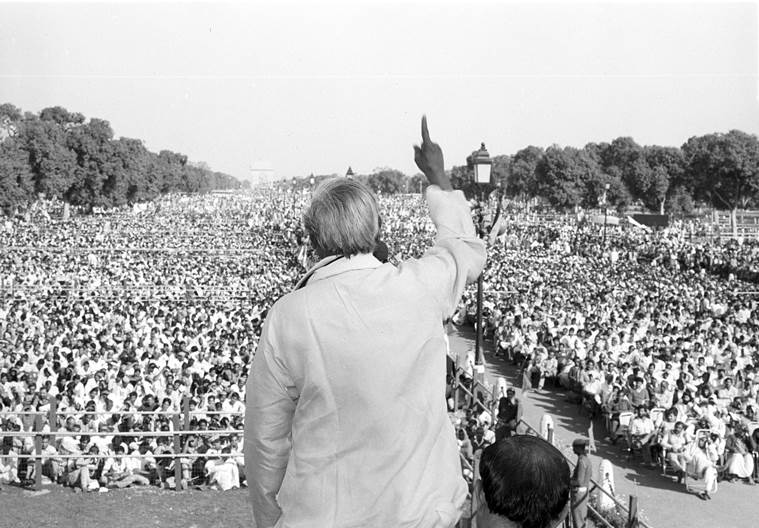 Atal Behari Vajpayee addressing the BJP rally at Boat club venue. (Express archive photo by S Paul)
Atal Behari Vajpayee addressing the BJP rally at Boat club venue. (Express archive photo by S Paul)
1980-1995
“Andhera chhatega, sooraj niklega aur kamal khilega (The shadows will part, the sun will shine and the lotus bloom)!” was how BJP president Vajpayee exhorted his party at its first plenary session in December 1980.
If the Jana Sangh had seen itself as a proponent of Upadhyaya’s ‘Integral Humanism’ philosophy, the Vajpayee-led BJP aligned itself to ‘Gandhian Socialism’. Around the same time, M C Chagla, an anti-Emergency leader, declared, “Who says there is no alternative to the Congress? I see the alternative in the form of the BJP. And in Atal Bihari Vajpayee, I see the alternative to Indira Gandhi.”
Vajpayee again saw aligning with non-Congress, non-Communist parties as the only way forward. But even as the BJP under him was trying to find its feet, Indira Gandhi’s assassination led to a sympathy wave for the Congress that drowned out the entire Opposition in the 1984 elections.
After the setback, the BJP virtually left behind Vajpayee’s Gandhian Socialism and returned to Integral Humanism. However, Vajpayee’s offer to resign as BJP chief at the party national executive in March 1985 was rejected, and he remained in the post till a year later, when he made way for Advani.
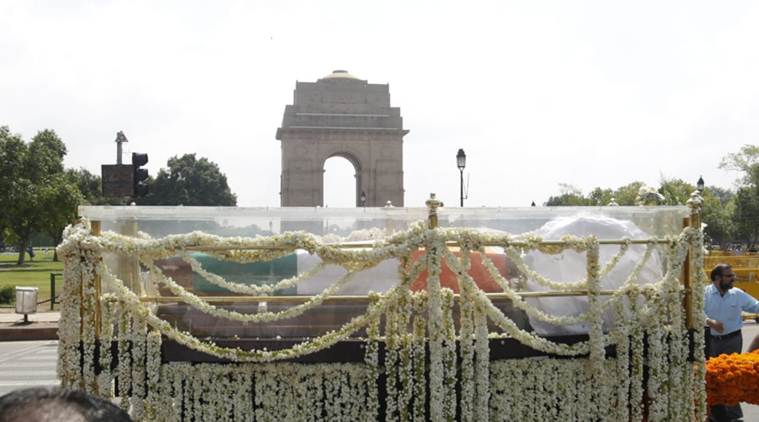 The mortal remains of Vajpayee crossing through India Gate. (Express photo by Praveen Khanna)
The mortal remains of Vajpayee crossing through India Gate. (Express photo by Praveen Khanna)
With Vajpayee and Advani having worked in tandem for so long, it is debatable how detached the poet-politician was from the new course the party took under his former deputy. In his first presidential speech itself, Advani raised the Shah Bano issue and called for a Uniform Civil Code. Soon after Advani began his second stint (in 1988), the BJP adopted a resolution on Ram Janmabhoomi in Ayodhya.
While the BJP rose to 89 seats in the 1989 elections on the strength of this Hindutva wave, it was V P Singh, who had split from the Congress on the Bofors issue, who formed the government. Short of majority, Singh, however, kept his distance from the ‘communal’ BJP, with only a tacit understanding between the two.
Under Advani, the BJP pressed ahead with its aggressive Hindutva, precipitating first the fall of the V P Singh government, and then the demolition of the Babri Masjid.
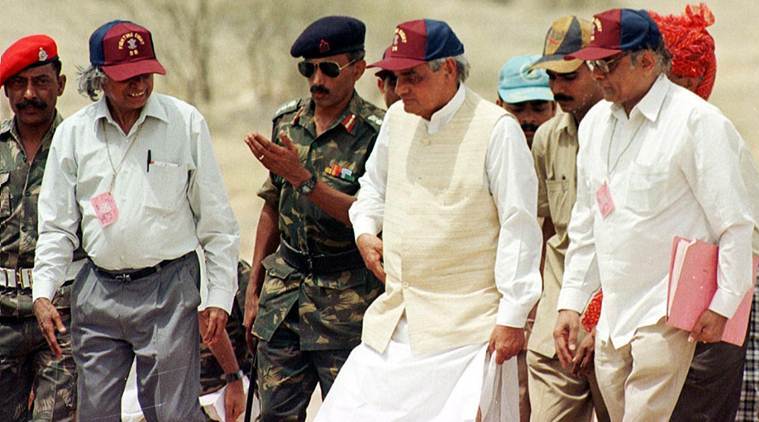
But while this helped the BJP rally a core base, for that to coalesce to give it momentum into power, again what was required was consensus man Vajpayee.
1995-2004
Before the first Lok Sabha elections in which the Congress did not have a Nehru-Gandhi at the helm, the BJP, spotting its best shot at power, seemed to recognise this need for Vajpayee. A few months before the Lok Sabha polls, in November 1995, Advani declared Vajpayee as PM candidate.
In the 1996 polls, the BJP plus allies — Shiv Sena, Samata Party and Haryana Vikas Party — won 187 seats. While 85 seats short of a majority, the BJP was called to form the government for being the single-largest block, and Vajpayee as PM made a passionate speech criticising the “unprincipled ganging up” of other parties against him. The speech was telecast live, and while he didn’t get the numbers and had to resign within 13 days, Vajpayee had won new admirers with his oratory.
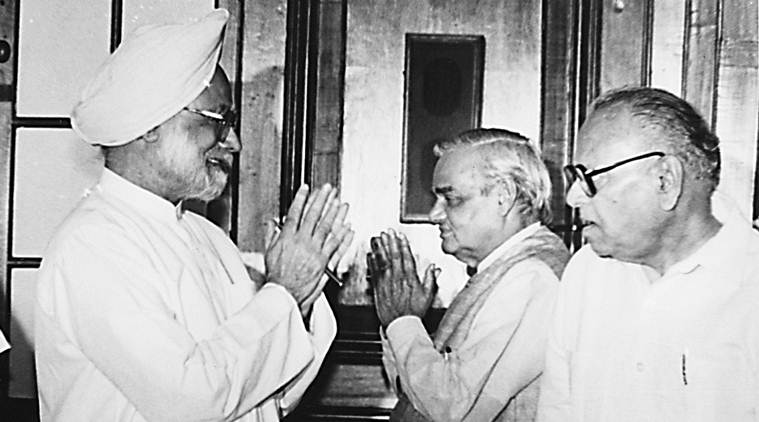 Dr Manmohan Singh with Atal Bihari Vajpayee. (Express Archive)
Dr Manmohan Singh with Atal Bihari Vajpayee. (Express Archive)
The United Front government that followed didn’t last, bringing mid-term elections in 1998. Vajpayee again was the BJP’s PM face, with the slogan of “Abki Baari, Atal Bihari”, The party saw an almost 40 per cent jump in its support base this time, to reach its highest ever tally of 9.43 crore votes and 182 Lok Sabha seats. Courtesy Vajpayee, the BJP had the support of 72 more MPs belonging to allies which, post-polls, included the TDP.
The Vajpayee-led 13-member NDA came to power in 1998, and within days, carried out the nuclear tests at Pokharan. While the government proved short-lived after the AIADMK pulled out, what helped the BJP going into the next elections was the Kargil War win, secured by Vajpayee as caretaker PM.
The NDA coalition returned to power in 1999 with, this time, the DMK as partner. Apart from being the first non-Congress government to complete its term, this Vajpayee regime also busted the myth that coalition governments in India were bound to fail. That devoid the Congress of its claim of being the only natural claimant to power.
It also marked the end of unipolar politics in the country.
2004-2018
The “isolated” BJP has now become the centerstage of Indian politics, Jaitley noted after Vajpayee’s death. “In an era dominated by the Nehruvian Congress, he (Vajpayee) created a political party which was an ideological alternative to the Congress… But for him, Advaniji and their other colleagues, Indian democracy would have looked different —dominated by one party, one family with a lot of scattered smaller parties.”
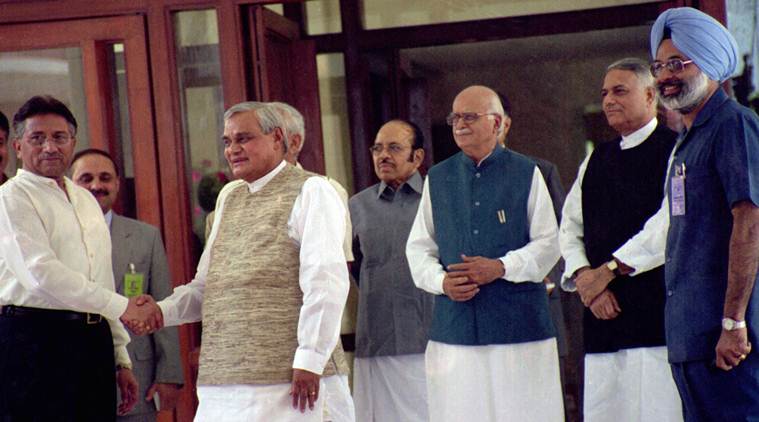 Atal Bihari Vajpayee with Pervez Musharraf. (File Photo)
Atal Bihari Vajpayee with Pervez Musharraf. (File Photo)
Ironically, what we may have today is just the reverse — with BJP opponents accusing the Narendra Modi-Amit Shah-led party of seeking to become the behemoth the Congress was by subsuming all opponents. However, for the BJP to be for 21st Century India what the Congress was in the 20th Century, for the party to spread its appeal across the Vindhyas, across communities and castes, there is still some distance to go.
And here again, it could need some of that Vajpayee touch. While his inaction during the 2002 Gujarat riots, that stretched to no more than a rap in the knuckles for CM Modi, would always be held against Vajpayee, he is also hailed for seeking peace with those considered the BJP’s traditional adversaries, from Pakistan to Kashmiri separatists.
While the current BJP government too cites its agenda as vikas, it was the Vajpayee government that showed a BJP administration could put this ahead of its core issues. With the Modi government beset with a series of contentious issues, the new BJP is seen as unable of that humility and give-and-take. However, party leaders say this is not the case. “Different times call for different strategies,” says a party MP. While the task before Upadhyaya and Mookerjee was to create the party from scratch, Vajpayee and Advani nourished it while Modi-Shah have to expand it now, he says, adding, “In Hinduism, we have different gods for different roles, for creation and perserverance. Why can we not accept the same of our leaders?”
Another party leader dismisses the charge that the BJP leadership itself is shrinking to the duo of Modi and Shah. He says, “The party’s current stalwarts were all beginners under Vajpayee and Advani. They developed a second- and third-rung leadership. Now leaders are created with power. Look at (Maharashtra Chief Minister) Devendra Fadnavis or (Tripura’s) Biplab Kumar Deb.”
Others point out that the BJP under Modi, despite its brute strength in the Lok Sabha and presence across the country, has 46 allies, wooing them particularly in areas considered beyond its reach. However, Naresh Gujral, a senior leader of the Akali Dal, one of the oldest partners of the BJP, says that going forward, the party will need to do more, especially in the south and especially to shed its anti-minority image. “To remain a national party, you can ignore minorities only at your peril,” Gujral says.
BJD leader Tathagata Satpathy, who has fond memories of Vajpayee from the time the two parties were in alliance, says the late PM “not only sought political cooperation but also dealt with every single NDA MP as an individual human being”. He also gives the examples of the BJP’s estranged ally Shiv Sena and the TDP, which has broken away from the NDA, to say “things are not the same” in the BJP when it comes to partners.
Asked what he would miss the most about Vajpayee, Union minister Prakash Javadekar remarks, “A person with a magnanimous heart is going to be missed.” Did Vajpayee understand all this better? Says Gujral, “He truly understood the essence of Indian scriptures, which is tolerance, compassion and secular values. He understood the basic syche of Indians — we tolerate everything but arrogance.”